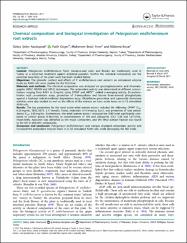| dc.contributor.author | Karatoprak, Gökçe Seker | |
| dc.contributor.author | Göğer, Fatih | |
| dc.contributor.author | Yerer, Mukerrem Betül | |
| dc.contributor.author | Koşar, Müberra | |
| dc.date.accessioned | 2019-10-19T14:15:18Z | |
| dc.date.available | 2019-10-19T14:15:18Z | |
| dc.date.issued | 2017 | |
| dc.identifier.issn | 1388-0209 | |
| dc.identifier.issn | 1744-5116 | |
| dc.identifier.uri | https://dx.doi.org/10.1080/13880209.2017.1314511 | |
| dc.identifier.uri | https://hdl.handle.net/11421/12754 | |
| dc.description | WOS: 000399479000044 | en_US |
| dc.description | PubMed ID: 28407721 | en_US |
| dc.description.abstract | Context: Pelargonium endlicherianum Fenzl. (Geraniaceae) roots and flowers are traditionally used in Turkey as a decoction treatment against intestinal parasites. Neither the chemical composition nor the potential bioactivity of the plant roots has been studied before. Objectives: The phenolic content and effects of P. endlicherianum root extracts on antioxidant enzyme levels on A549 cells were studied for the first time. Materials and methods: The chemical composition was analyzed via spectrophotometric and chromatographic (HPLC MS/MS and HPLC) techniques. The antioxidant activity was determined at different concentrations ranging from 0.001 to 2 mg/mL using DPPH center dot and ABTS center dot(+) radical scavenging activity, beta-carotenelinoleic acid co-oxidation assay, protection of 2-deoxyribose and bovine brain-derived phospholipids against a hydroxyl radical-mediated degradation assay. Glutathione peroxidase and superoxide dismutase activities were also studied as well as the effects of the extracts on nitric oxide levels on IL-1 beta stimulated A549 cells. Results: The key parameters for the most active ethyl acetate extract included the following: DPPH center dot IC50: 0.23mg/mL, TEAC/ABTS: 2.17mmol/L Trolox, reduction: 0.41mmol/g AsscE, and protection of lipid peroxidation IC50: 0.05 mg/mL. Furthermore, the ethyl acetate extract increased the SOD level significantly compared to control group (4.48U/mL) at concentrations of 100 and 200 mu g/mL SOD, 5.50 and 5.67 U/mL, respectively. Apocynin was identified as the major component, and the ethyl acetate fraction was found to be rich in phenolic compounds. Discussion and conclusion: Pelargonium endlicherianum root extracts displayed antioxidant activity and increased the antioxidant enzyme levels in IL-1 beta stimulated A549 cells, while decreasing the NO levels. | en_US |
| dc.description.sponsorship | Erciyes University Research Council [TDK-2013-4164] | en_US |
| dc.description.sponsorship | This work was supported by the Erciyes University Research Council (Project no: TDK-2013-4164). | en_US |
| dc.language.iso | eng | en_US |
| dc.publisher | Taylor & Francis LTD | en_US |
| dc.relation.isversionof | 10.1080/13880209.2017.1314511 | en_US |
| dc.rights | info:eu-repo/semantics/openAccess | en_US |
| dc.subject | Geraniaceae | en_US |
| dc.subject | Antioxidant Activity | en_US |
| dc.subject | Hplc/Ms/Ms | en_US |
| dc.subject | A549 Cells | en_US |
| dc.title | Chemical composition and biological investigation of Pelargonium endlicherianum root extracts | en_US |
| dc.type | article | en_US |
| dc.relation.journal | Pharmaceutical Biology | en_US |
| dc.contributor.department | Anadolu Üniversitesi, Eczacılık Fakültesi, Farmakognozi Anabilim Dalı | en_US |
| dc.identifier.volume | 55 | en_US |
| dc.identifier.issue | 1 | en_US |
| dc.identifier.startpage | 1608 | en_US |
| dc.identifier.endpage | 1618 | en_US |
| dc.relation.publicationcategory | Makale - Uluslararası Hakemli Dergi - Kurum Öğretim Elemanı | en_US |
| dc.contributor.institutionauthor | Göğer, Fatih | |
| dc.contributor.institutionauthor | Koşar, Müberra | |


















